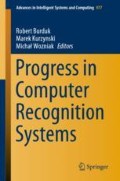Abstract
The families of graph grammars used in syntactic pattern recognition are characterized in the paper. The reasons for the intractability of the problem of graph language parsing are presented. The methodological principles for the constructing of efficient syntax analysis schemes for graph-based syntactic pattern recognition are discussed.
Access this chapter
Tax calculation will be finalised at checkout
Purchases are for personal use only
References
Bishop CM (2006) Pattern recognition and machine learning. Springer, New York
Bunke H (1982) Attributed programmed graph grammars and their application to schematic diagram interpretation. IEEE Trans Pattern Anal Mach Intell 4:574–582
Bunke H, Haller B (1990) A Parser for context free plex grammars. In: Lecture Notes in Computer Science, vol 411. Springer, Heidelberg, pp 136–150
Bunke H, Sanfeliu A (eds) (1990) Syntactic and structural pattern recognition - theory and applications. World Scientific, Singapore
Duda RO, Hart PE, Stork DG (2001) Pattern classification. Wiley, New York
Earley J (1970) An efficient context-free parsing algorithm. Commun. ACM 13:94–102
Flasiński M (1988) Parsing of edNLC-graph grammars for scene analysis. Pattern Recogn 21:623–629
Flasiński M (1990) Distorted pattern analysis with the help of nodel label controlled graph languages. Pattern Recogn 23:765–774
Flasiński M (1993) On the parsing of deterministic graph languages for syntactic pattern recognition. Pattern Recogn 26:1–16
Flasiński M (1995) Use of graph grammars for the description of mechanical parts. Comput-Aided Des 27:403–433
Flasiński M (1998) Power properties of NLC graph grammars with a polynomial membership problem. Theor Comput Sci 201:189–231
Flasiński M (2007) Inference of parsable graph grammars for syntactic pattern recognition. Fundam Inf 80:379–413
Flasiński M (2016) Chapter 1: syntactic pattern recognition: paradigm issues and open problems. In: Chen, C.H. (ed.) Handbook of pattern recognition and computer vision, 5th edn. World Scientific, New Jersey/London/Singapore, pp 3–25
Flasiński M (2016) Introduction to artificial intelligence. Springer, Switzerland
Flasiński M (2019) Syntactic pattern recognition. World Scientific, New Jersey/London/Singapore
Flasiński M, Kotulski L (1992) On the use of graph grammars for the control of a distributed software allocation. Comput J 35:A165–A175
Flasiński M, Myśliński S (2010) On the use of graph parsing for recognition of isolated hand postures of Polish sign language. Pattern Recogn 43:2249–2264
Feder J (1971) Plex languages. Inf Sci 3:225–241
Fu KS (1982) Syntactic pattern recognition and applications. Prentice Hall, Upper Saddle River
Gonzales RC, Thomason MG (1978) Syntactic pattern recognition: an introduction. Addison-Wesley, Reading
Han F, Zhu SC (2009) Bottom-up/top-down image parsing with attribute grammar. IEEE Trans Pattern Anal Mach Intell 31:59–73
Janssens D, Rozenberg G (1980) On the structure of node-label-controlled graph languages. Inf Sci 20:191–216
Knuth DE (1965) On the translation of languages from left to right. Inf Control 8:607–639
Kulikowski JL (1971) Algebraic methods in pattern recognition. Springer, Wien
Lewis PM II, Stearns RE (1968) Syntax-directed transduction. J ACM 15:465–488
Lin L, Wu T, Porway R, Xu Z (2009) A stochastic graph grammar for compositional object representation and recognition. Pattern Recogn 42:1297–1307
Liu X, Zhao Y, Zhu SC (2018) Single-view 3D scene reconstruction and parsing by attribute grammar. IEEE Trans Pattern Anal Mach Intell 40:710–725
Park S, Nie BX, Zhu SC (2018) Attribute And-Or grammar for joint parsing of human attributes, parts and poses. IEEE Trans Pattern Anal Mach Intell 40:1555–1569
Pavlidis T (1977) Structural pattern recognition. Springer, New York
Pei M, Si Z, Yao BZ, Zhu SC (2013) Learning and parsing video events with goal and intent prediction. Comput Vis Image Underst 117:1369–1383
Peng KJ, Yamamoto T, Aoki Y (1990) A new parsing scheme for plex grammars. Pattern Recogn 23:393–402
Rosenkrantz DJ, Stearns RE (1970) Properties of deterministic top-down grammars. Inf Control 17:226–256
Sanfeliu A, Fu KS (1983) Tree-Graph Grammars for Pattern Recognition. In: Lecture Notes in Computer Science, vol 153. Springer, Heidelberg, pp 349–368
Shi QY, Fu KS (1983) Parsing and translation of attributed expansive graph languages for scene analysis. IEEE Trans Pattern Anal Mach Intell 5:472–485
Zarchi MS, Tan RT, Van Gemeren C, Monadjemi A, Veltkamp RC (2016) Understanding image concepts using ISTOP model. Pattern Recogn 53:174–183
Zhu SC, Mumford D (2006) A stochastic grammar of images. Found Trends Comput Graph Vis 2:259–362
Author information
Authors and Affiliations
Corresponding author
Editor information
Editors and Affiliations
Rights and permissions
Copyright information
© 2020 Springer Nature Switzerland AG
About this paper
Cite this paper
Flasiński, M. (2020). Graph Grammar Models in Syntactic Pattern Recognition. In: Burduk, R., Kurzynski, M., Wozniak, M. (eds) Progress in Computer Recognition Systems. CORES 2019. Advances in Intelligent Systems and Computing, vol 977. Springer, Cham. https://doi.org/10.1007/978-3-030-19738-4_1
Download citation
DOI: https://doi.org/10.1007/978-3-030-19738-4_1
Published:
Publisher Name: Springer, Cham
Print ISBN: 978-3-030-19737-7
Online ISBN: 978-3-030-19738-4
eBook Packages: Intelligent Technologies and RoboticsIntelligent Technologies and Robotics (R0)

